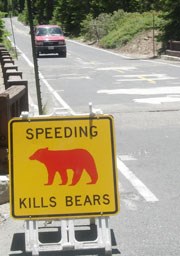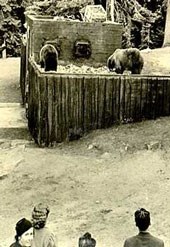|
Yosemite National Park managers work to protect the American black bear in Yosemite National Park so that it can continue its healthy existence for future generations of visitors to see. The challenge: The species, by its nature, can easily be corrupted by human errors, such as approaching too closely or poor food storage practices. For these reasons, research is on the forefront. As scientists learn more, the emphasis, in some cases, is on managing the behavior of humans rather than the behavior of bears. View current current statistics. 
'Red Bear' SignageOne of the most visible bear management tools is the "Red Bear-Dead Bear" signage. To minimize collisions between cars and wildlife in Yosemite National Park, an education initiative began in 2007. The red bear program aims to increase visitor awareness of the high frequency of vehicle-animal collisions, to encourage visitors to be aware of wildlife along roadsides, and to observe posted speed limits. Typically a dozen or more black bears are killed or maimed each year by vehicles; in 2010, 28 vehicle-bear collisions were reported. The program includes 18 metal signs, illustrated with a red bear, positioned off the road where collisions in the park occurred. The attention-grabbing sign design and coloration is based on recommendations from a 2003 Wyoming roadway and wildlife crossing study. It indicated that traditional wildlife crossing signs, such as a yellow diamond-shaped sign with a black leaping deer, are often ineffective in mitigating vehicle-animal collisions, but innovative signage of animal silhouettes, in conjunction with a public education and awareness campaign, can be effective. Since the Yosemite project began, the park has received an increase in reports of vehicle-bears collisions, but it's unclear to scientists if more bears have been hit by cars of if the sign campaign simply has encouraged the public to report collisions they witness. Yosemite's signage project also includes educational displays, in the form of flyers and posters, at entrance stations, visitor centers, and stores. Evaluation of this program is still ongoing. 
NPS Historic Photo Collection Search for Human FoodManagement was not the same early in the park's history, when little was done to keep bears from becoming conditioned to human food. The National Park Service even maintained several bear feeding areas in the park where bears were fed for entertainment reasons and “bear pits” of trash dumped in a small area to entice bears from park campgrounds and lodging areas. Many bears had to be killed in the name of public safety because bears exposed to human food change their behavior, sometimes becoming aggressive. The result can be property damage or dangerous confrontations. Bears that become used to people (habituated) lessen their use of natural foods, become more nocturnal, and may travel to higher elevations due to potential human food availability. Expect black bears to attempt amazing acts to obtain human food. If food has been left in a car, bears will break vehicle windows, bend car frames, and pop open camper shells. To get into a trunk, they will enter the passenger area and claw through the back seat. Because bears can claw open unsecured dumpster lids and pull out trash, all of Yosemite’s outdoor garbage cans and dumpsters are bear-resistant. All campsites, parking lots, and major trailheads are equipped with bearproof food lockers that allow visitors to remove food from their cars overnight and store it safely away from bears. Visitors are required to use the food lockers (referred to as bear boxes) that exist in all campsites. Campers should not let their guard down: Some bears have resorted to entering during mealtime hours to grab food from open vehicles and picnic tables. 
Research into ActionTo scare bears away from public areas, rangers often chase bears from developed areas, or shoot bears with rubber slugs or bean bag rounds from a shotgun. Bears rarely are relocated because they return quickly to the place of capture and resume food-conditioned behavior. Tagged, or radio collared, bears do not mean the bear is a “bad” bear. Tagging bears is done for better monitoring, and the ear tag color is completely random, used to help quickly identify a bear. This efforts allows scientists to follow a few of the 300 to 500 bears that live in Yosemite. Read the Yosemite Bear Team Blog to learn more about the challenges and successes of the bear team. The Hornocker Wildlife Institute, a program of the Wildlife Conservation Society, examined factors influencing human-bear interactions in order to accurately identify methods to improve bear management and reduce the number of human-bear incidents. Suggestions included maintaining personal contacts by park staff to remind visitors of regulations, stronger law enforcement efforts, and more aggressive aversive conditioning techniques on bears in developed areas. See the full 2000-2003 reports below. Learn MoreBears have become the subject of intense management efforts so they don’t have to pay for human mistakes with their lives. Read more about bear management here:
References
|
Last updated: November 19, 2024
